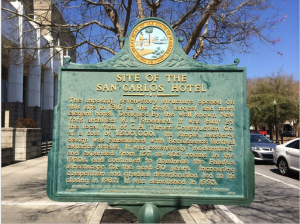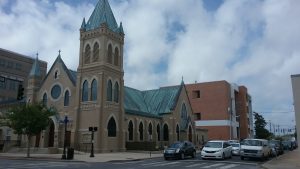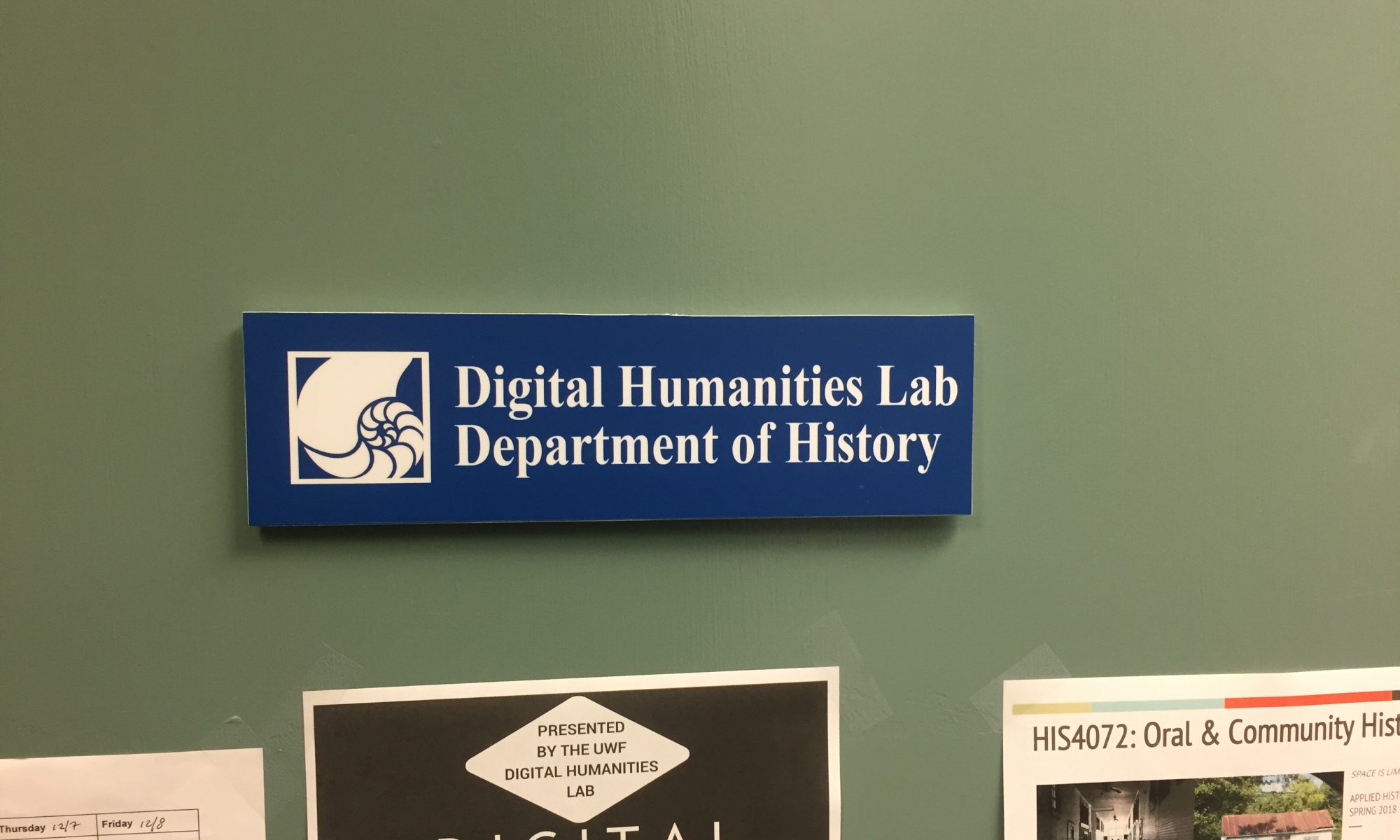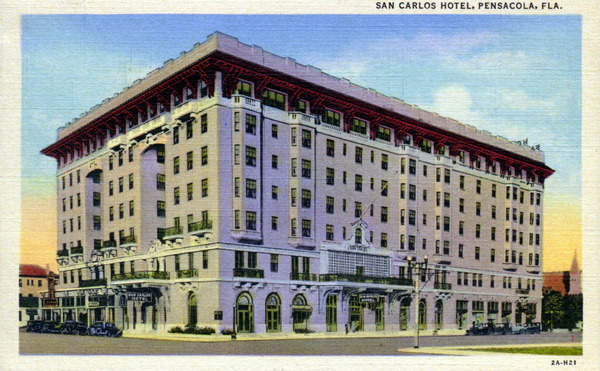On June 24, 1908, the headline in Pensacola Journal read, “A Name for the New Hotel.” Residents in the Pensacola area and beyond submitted names for a new hotel bought my James Michael Mulden, Frasier Franklin Bingham, and George and Charles Hervey. Bingham served on multiple organization boards like the Pensacola Hotel Company, the same team that supported the construction of the unnamed hotel.

The First Methodist Church in the city sold the property due to the growth of their congregation. The editor of the Journal writes, “If a name indicative of the Spanish colonial settlement of Pensacola is to be given it should be called Puerta D’Anchusi or Hotel D’Anchusi.”[1] The owners of the hotel decided to pay homage to the Five Flags history of Pensacola and sought to honor the Spanish beginnings of the city. The newspaper featured three names: The Gulf City Hotel, Escola Hotel, and the San Carlos Hotel. An Alabama man suggested created the Escola by taking the first and last syllables of Escambia County and Pensacola. San Carlos referenced the fort of the same name near Fernandina Beach. The Spanish completed the fort in 1816. It carried at least eight guns and was vulnerable to attack as the Spanish Empire came to an end. By January 16, 1909, the Pensacola Journal affirmed the name of the hotel: Hotel San Carlos.

The Pensacola Hotel Company, contractor Chase H. Turner, and owner of the San Carlos named the hotel for the half million-dollar hotel. Furthermore, “the ‘San Carlos’ is typical of Pensacola and of Florida. It suggests at once the romance and chivalry of the early Spanish days and it is distinctive in that there is no other hotel of similar name.”[2] Construction began in 1908 with an estimated opening on January 1, 1910. The Turner Construction Company provided the concrete foundation of the building. In effort to ensure the longevity of the building, steel and masonry replaced wooden frames.[3] The San Carlos continually modernized its facility, offered new accommodations like full bathrooms in individual rooms. Most hotel floors shared restrooms. The hotel had 157 rooms but progressed to 403.

It was seven stories, making it the city’s largest hotel at the time. The hotel represented not only elegance and economic stability, but it was an invitation to the world to visit Pensacola. The very mention of the Hotel San Carlos in the Pensacola Journal garnered positive response as evidenced from articles like “Pensacola City of Progress and Opportunity.”[4] The Journal published stories about prosperity and “planting your savings seed in good old Pensacola soil.” Suddenly, residents in the area had an opportunity to influence the development of the city! The Real Estate Market increased the frequency of their newspaper advertisements to entice current residents and to attract more. On February 1, 1910 the grand opening of the Hotel San Carlos, Pensacola was aglow with excitement and celebration. It occurred the same weekend as Mardi Gras and filled the city with “unlimited confidence.”[5]
Recommended Readings
The Pensacola Journal. (Pensacola, Fla.), 24 June 1908. Chronicling America: Historic American Newspapers. Library of Congress. http://chroniclingamerica.loc.gov/lccn/sn87062268/1908-06-24/ed-1/seq-4/.
The Pensacola Journal. (Pensacola, Fla.), 16 Jan. 1909. Chronicling America: Historic American Newspapers. Library of Congress. http://chroniclingamerica.loc.gov/lccn/sn87062268/1909-01-16/ed-1/seq-1/.
The Pensacola Journal. (Pensacola, Fla.), 31 March 1909. Chronicling America: Historic American Newspapers. Library of Congress. http://chroniclingamerica.loc.gov/lccn/sn87062268/1909-03-31/ed-1/seq-7/.
The Pensacola Journal. (Pensacola, Fla.), 14 March 1909. Chronicling America: Historic American Newspapers. Library of Congress. http://chroniclingamerica.loc.gov/lccn/sn87062268/1909-03-14/ed-1/seq-10/.
The Pensacola Journal. (Pensacola, Fla.), 23 Jan. 1910. Chronicling America: Historic American Newspapers. Library of Congress. http://chroniclingamerica.loc.gov/lccn/sn87062268/1910-01-23/ed-1/seq-7/.
[1] The Pensacola Journal. (Pensacola, Fla.), 24 June 1908. Chronicling America: Historic American Newspapers. Library of Congress. http://chroniclingamerica.loc.gov/lccn/sn87062268/1908-06-24/ed-1/seq-4/.
[2] The Pensacola Journal. (Pensacola, Fla.), 16 Jan. 1909. Chronicling America: Historic American Newspapers. Library of Congress. http://chroniclingamerica.loc.gov/lccn/sn87062268/1909-01-16/ed-1/seq-1/.
[3] The Pensacola Journal. (Pensacola, Fla.), 31 March 1909. Chronicling America: Historic American Newspapers. Library of Congress. http://chroniclingamerica.loc.gov/lccn/sn87062268/1909-03-31/ed-1/seq-7/.
[4] The Pensacola Journal. (Pensacola, Fla.), 14 March 1909. Chronicling America: Historic American Newspapers. Library of Congress. http://chroniclingamerica.loc.gov/lccn/sn87062268/1909-03-14/ed-1/seq-10/.
[5] The Pensacola Journal. (Pensacola, Fla.), 23 Jan. 1910. Chronicling America: Historic American Newspapers. Library of Congress. http://chroniclingamerica.loc.gov/lccn/sn87062268/1910-01-23/ed-1/seq-7/.
Featured Image:
San Carlos Hotel – Pensacola, Florida. State Archives of Florida, Florida Memory. Accessed April 15. https://www.floridamemory.com/items/show/160675.
Author: Mariah Mills
Researcher ID: 0000-0002-5323-8034

